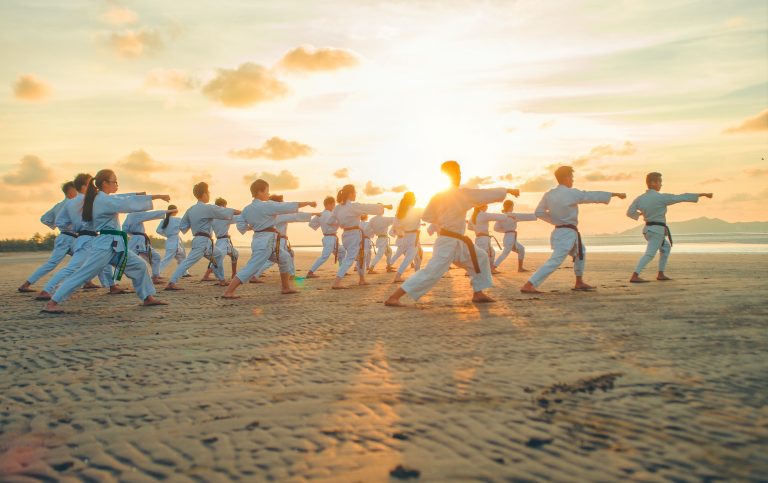The Karate Belt Ranking System: Understanding the Levels of Mastery
Karate is a popular martial art practiced by millions of people around the world. It is known for its punches, kicks, and strikes, but it is also recognized for its unique ranking system. The karate belt ranking system is used to indicate the level of expertise and skill that a student has achieved in the art of karate. In this blog post, we will discuss the different levels of karate belts and what they represent.
The Origins of the Karate Belt Ranking System
The karate belt ranking system originated from the Japanese system of ranking called “kyu and dan.” The kyu ranks are the lower ranks and the dan ranks are the higher ranks. The karate belt system adopted this ranking system and added different colors to the belts to indicate different levels of proficiency. The belt system also helped to motivate karate students to work harder and progress to higher levels.
The Different Levels of Karate Belts
There are six belt colors that students must earn before they can achieve the black belt. These colors are white, yellow, orange, green, blue, and brown. Each belt color signifies a different level of proficiency and skill.
White Belt
The white belt is the starting point for every karate student. It symbolizes purity, innocence, and the beginning of the journey. Students learn about the basic techniques and fundamental principles of karate. They also learn about the etiquette and discipline required in a karate dojo.
Yellow Belt
The yellow belt signifies the first step towards becoming a skilled karate practitioner. Students learn about more advanced techniques and continue to develop their physical abilities. The yellow belt also teaches the importance of focus, determination, and perseverance.
Orange Belt
The orange belt is a step up from the yellow belt and signifies an improvement in technique and skill. Students at this level learn about more complex techniques and strategies. They also focus on developing their balance, coordination, and speed.
Green Belt
The green belt is the halfway mark towards achieving the black belt. Students at this level have a good grasp of the fundamental principles of karate and have developed a high level of proficiency in their techniques. They also learn about the importance of timing, distance, and rhythm in karate.
Blue Belt
The blue belt signifies a high level of proficiency in karate. Students at this level have mastered the basic techniques and have developed advanced skills. They also learn about the importance of strategy, tactics, and psychology in karate.
Brown Belt
The brown belt is the last step before the coveted black belt. Students at this level have mastered all the techniques and have developed a high level of skill and proficiency. They also learn about the importance of physical and mental conditioning and are expected to mentor and motivate other students.
The Meaning of the Black Belt
The black belt is the ultimate goal for every karate student. It signifies mastery, excellence, and dedication to the art of karate. Earning a black belt is a significant achievement, and it requires years of training, discipline, and hard work.
The journey towards the black belt is not just about becoming a skilled martial artist but also about developing a strong character. Karate students learn about the importance of humility, respect, and self-discipline. They also develop mental toughness and resilience, which helps them overcome challenges both inside and outside the dojo.
Frequently Asked Questions about Karate Belt Ranking System
If you are practicing Karate for a while now, you must have noticed that practitioners wear different colored belts that signify different levels of experience, knowledge, and skills. The karate belt ranking system is a crucial pillar of the martial art, and it guides students on their journey to mastery. However, if you’re new to Karate, you might have a lot of questions about the belt ranking system. In this blog post, we will answer some of the most frequent questions about Karate belt ranking system.
What is the Karate Belt Ranking System?
The Karate belt ranking system is a way of tracking a student’s progress through different levels of training. It starts from a beginner’s white belt and progresses through different colored belts, such as yellow, orange, green, blue, purple, brown, and black. Each level is a symbol of the level of expertise of a student.
What is the significance of the belt colors?
Each belt color represents a specific level of skill, knowledge, and experience that a student has attained. The basic concept behind the belt colors is that white signifies a beginner, and black signifies a master. The different colors between white and black signify the progress of the student as they advance through the levels of training.
How long does it take to achieve each belt rank?
The amount of time it takes to achieve each belt rank varies from dojo to dojo and from one martial art style to another. Generally, it takes about 2-3 months of training to earn a white belt. After that, the amount of time between each rank increases. On average, it takes around 3-5 years of consistent training to earn a black belt, but this is not a set timeline. Some martial artists achieve their black belts in a shorter time, while others take longer.
What are the requirements for each belt rank?
The requirements for each belt rank also vary from dojo to dojo and from one martial art style to another. In general, the requirements involve both physical and mental aspects of training, including techniques, katas, sparring, and knowledge of the principles and philosophy of the martial art.
Do I need to compete to earn a higher belt rank?
No, competing is not a requirement to earn a higher belt rank. However, competition can be an essential part of training as it allows students to test their skills against other practitioners of the same level. Moreover, some dojos, tournaments, or organizations may require competitors to have achieved a specific belt rank before they can participate in competitions.
Is the Karate belt ranking system standardized across different martial arts styles?
No, the belt ranking system is not standardized across different martial arts styles. Some styles have more belts or fewer belts, while others have different colors for the same levels. Therefore, it is essential to know the specific requirements and interpretations of the belt system of the style you are training in.
Can I skip a belt color?
Skipping a belt color is possible but uncommon. In general, students have to pass the requirements for each belt color before they can advance to the next level. However, some instructors or schools may waive some of the requirements if a student’s skills and knowledge meet the standards for the next belt rank.
Is it possible to lose a belt rank?
Yes, it is possible to lose a belt rank. However, it is generally reserved for cases in which a student has egregiously violated the principles and ethics of the martial art or the dojo.
What is the highest Karate belt rank?
The highest Karate belt rank is the tenth-degree black belt. However, it is exceptionally rare to achieve and generally reserved for those who have dedicated their entire lives to the study and practice of the martial art.
Wrapping Up
The Karate belt ranking system is a crucial guide for students‘ progress in the martial art. It signifies both the level of expertise and the dedication of a student to the practice. By answering some of the most frequent questions about the belt ranking system, we hope we have provided you with a clearer understanding of the meaning and significance of the belts you see at your dojo. Remember that the belt colors are just symbols, and the true aim of Karate training is self-improvement, discipline, and respect.
Karate Belt Ranking System: A Comprehensive Guide
Karate is a popular martial art that originated in Japan. Its belt ranking system is well-known and respected, and it serves to indicate a student’s level of skill and knowledge within the art. In this guide, we’ll provide a detailed overview of the karate belt ranking system, what each belt means, and how to progress through the ranks.
What Is the Karate Belt Ranking System?
The karate belt ranking system is a way of measuring a student’s progress and skill level within karate. The system consists of different colored belts, each representing a different level of mastery. The order of the belts typically includes white, yellow, orange, green, blue, purple, brown, and black. However, some schools may have additional colors or different levels of rankings.
How Does the Karate Belt Ranking System Work?
In order to progress through the karate belt ranking system, students must demonstrate their understanding and mastery of various techniques and forms. Each belt level has specific requirements that students must meet in order to advance. These requirements may include attending a certain number of classes, practicing specific techniques or forms, and demonstrating proficiency in sparring or self-defense.
What Do the Different Belt Colors Mean?
Each belt color within the karate belt ranking system represents a particular level of skill and knowledge. Here’s a breakdown of what each belt color means:
– White Belt: The white belt is the starting point for all students. It represents innocence and an eagerness to learn.
– Yellow Belt: The yellow belt signifies the first level of basic understanding and skill in karate.
– Orange Belt: The orange belt indicates that the student has progressed beyond the basic level and is beginning to develop a greater understanding of the art.
– Green Belt: The green belt is a stepping stone to more advanced techniques and indicates that the student is becoming more proficient in their skills.
– Blue Belt: The blue belt represents a deeper understanding of karate and indicates that the student is developing a greater appreciation for the art.
– Purple Belt: The purple belt denotes a higher level of skill and knowledge, and students at this level are considered intermediate-level practitioners.
– Brown Belt: The brown belt represents a mastery of the fundamental techniques and is the last step before achieving the coveted black belt.
– Black Belt: The black belt is the highest level within the karate belt ranking system and represents mastery of the art.
How Do You Progress Through the Karate Belt Ranking System?
In order to progress through the karate belt ranking system, students must demonstrate proficiency in the various techniques and forms required for each level. Here’s what you can expect at each level:
– White Belt: As a white belt, you’ll begin by learning basic techniques such as punches, kicks, and blocks. You’ll also learn how to bow properly and show respect to your instructor and fellow students.
– Yellow Belt: At the yellow belt level, you’ll be expected to demonstrate a basic understanding of these techniques and be able to perform them with more power and accuracy.
– Orange Belt: The orange belt level involves more complex techniques and forms, as well as an increased emphasis on sparring and self-defense.
– Green Belt: The green belt level requires a deeper understanding of the art, and students will be expected to perform more advanced techniques and forms with precision.
– Blue Belt: At the blue belt level, students will begin to focus on more specialized techniques and forms.
– Purple Belt: The purple belt level is considered intermediate, and students will be expected to hone their skills to a high level of proficiency.
– Brown Belt: As a brown belt, students will focus on mastering the fundamental techniques and preparing for their black belt test.
– Black Belt: Achieving a black belt requires a demonstration of proficiency in all areas of karate. Students will be required to master advanced techniques and forms, as well as demonstrate a deep understanding of the art and its history.
Conclusion
The karate belt ranking system serves as a way to measure a student’s progress and skill level within karate. By understanding the different belt colors and what they represent, students can set goals for themselves and work towards achieving mastery of the art. If you’re interested in pursuing karate, we encourage you to find a reputable school and speak with an instructor about their specific belt ranking system and requirements.
Inhaltsverzeichnis





